
The Daily Standard office, 123 E. Market St., Celina, Ohio, in the 1950s.
A case could be made that the era of modern communication began with the first commercial telegraph messages in 1844. Two years later, five New York newspapers joined forces to share dispatches and telegraph charges from the Mexican-American War. They called their little collective The Associated Press. And two years after that, in a small town near the Ohio-Indiana border, a couple of guys - their names lost to history - published the first issue of The Western Standard.
Much of Ohio was wilderness in 1848. Log cabins dotted clearings. The Miami and Erie Canal was only three years old, the fabled waterway cutting through what would become part of The Daily Standard's circulation area. And a man's horse was his best friend.
Some accounts of The Western Standard's origin say the founders were named Hunter and Barrington. Another story calls them Millard and Smith. And a guy named Blocher had an interest in the whole operation for a while. But the only name that matters, the only name you need to remember is Snyder.

Some of the business management team and circulation personnel from the mid-1950s. Seated, from left: Joy and Parker Snyder and Susie Quinter. Standing, Bill Hale, Jean Clifton, Mary Ellen Winkeljohn and Trudy Boroff. Joy and Parker were brother and sister. Parker's four children - Adelle, Frank M., Lillian and Jacob - formed the fourth generation of newspaper Snyders.
Since the 1850s, the Snyders of Mercer County have owned and managed the newspaper that became The Daily Standard.
It's a remarkable achievement.
In a world where most small businesses fail in the first year, The Daily Standard has lasted nearly two centuries.
It means the paper survived a civil war and two world wars. It survived one "great" depression and a lot of smaller recessions. It means this newspaper made it while a lot of other good newspapers were gobbled up and gutted by hedge funds or giant conglomerates.
A newspaper that was here before the light bulb is still publishing in the internet age.
The Standard was publishing long before those guys from Dayton flew their first airplane.
The Standard was publishing when a kid from Wapakoneta took his first steps on the moon.
And because each generation of Snyders cared about community journalism and stuff like the First Amendment, you're able to read this story today.
The history of The Daily Standard and the genealogy of the Snyder family are, for all intents and purposes, one and the same. That makes this newspaper both a cherished family heirloom and a critical public trust, one of the oldest active newspapers in America still owned by the same family.
That's an anniversary worth celebrating.
---
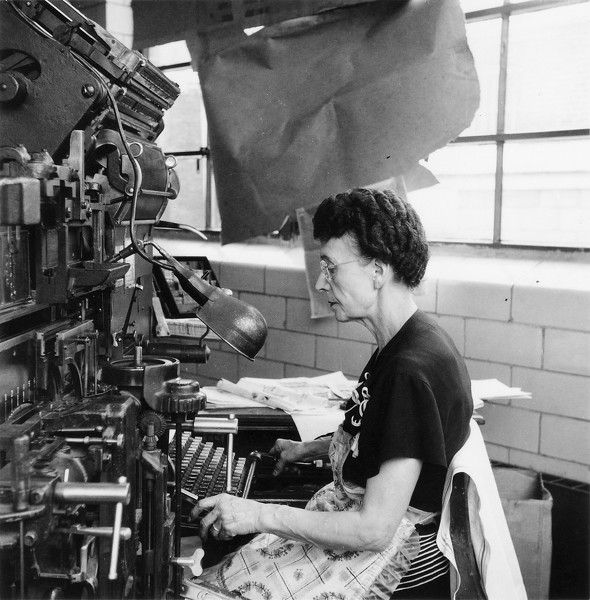
Clara Kellermayer at her Linotype keyboard in the 1950s.
Since its inception, The Daily Standard has been on the vanguard of industry innovation and technological advancements, always bracing itself for changes as it strives to best serve its readership
"If I had to reduce my career to one word, it would be change," said Frank Snyder, publisher of The Daily Standard. "Incrementally, something was happening. It may not have occurred, but we were getting ready for something."
As a boy, Frank Snyder said his family would make stops at daily newspapers during summer vacations across the country. His father, Parker, would converse with publishers to learn what equipment and practices worked best for them and consider putting them in place at The Daily Standard.
"We were in so many newspapers," Frank Snyder said.
Parker also took his kids along when making equipment purchases.
Upon becoming publisher, Frank Snyder maintained his father's commitment to staying abreast of new developments and incorporating them into The Daily Standard.
For instance, at a National Newspaper Association convention, Frank saw a demonstration on the then new software program called Photoshop and what it could do for newspaper pictures.
He soon afterward introduced Photoshop in the newsroom.
"I could see the handwriting on the wall for the Compugraphic equipment and the phototype setting material," he said.
However, as much as the Snyder family kept up with modernizing the news room and printing press, they steadfastly resisted one industry trend that emerged in the 90s - the corporate takeover of independent newspapers.
The family watched as corporations gutted newsrooms and cut back on local news coverage in pursuit of higher profits and the adverse effects these moves had on the communities they served.
"We knew what would happen," Frank Snyder said.
Still, it's a tough fight for a family-owned newspaper to stay afloat in a world where people expect free news content on the internet, but one worth waging to keep residents informed of happenings in their local governments, schools and communities.
"Our competition is Google and … all the small retail operations in the U.S. … is Amazon," he said. "But if you don't want to have these other operations around, you're voting with your wallet."
— William Kincaid
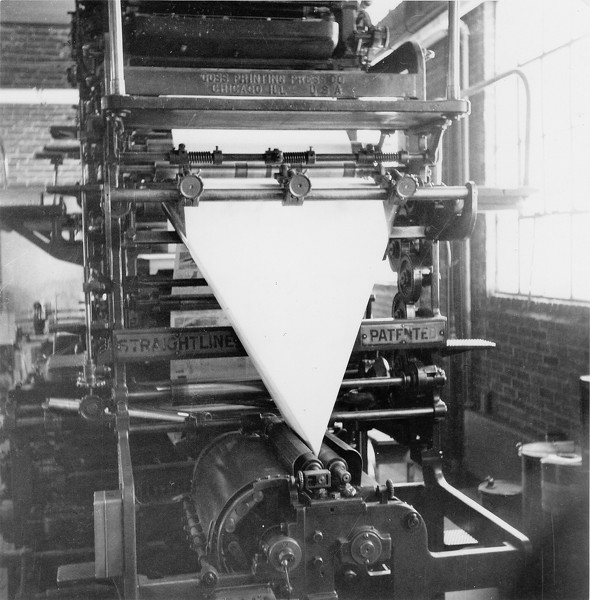
The press and folder in the 1950s.
---
Lil Snyder Keefer, 71, works as the advertising composition manager for The Daily Standard. She designs and sets the advertisements.
Starting in the third grade, Keefer remembers coming to the newsroom at night to turn on the lead pots for the Linotype machines. She said she started as a stuffer and moved up to delivering newspapers. She also proofread and ran the Fairchild, an engraving machine.
Keefer said she is amazed at the technological advances over the last 175 years.
"It's sort of been amazing going from hot type to cold type," she said. "I'm sort of a relic."
Hot type involved hot lead to make the mold of the lead plate. Cold type is computer-generated.
— Erin Gardner
---
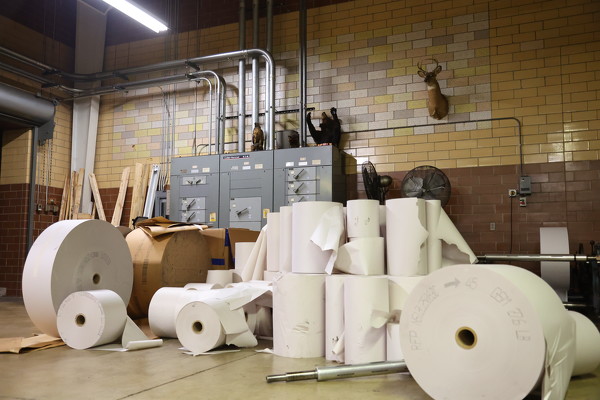
Giant rolls of paper. Some are new, others are partially used.
One roll of paper weighs 600 pounds and can be made into 17,000 newspapers. The Daily Standard goes through a portion of three rolls per edition. One roll of paper stretches from Celina to St. Marys, or about seven miles.
The current Daily Standard printing press was originally a Goss straight line quadruple press. The press is now an assembly of three different units.
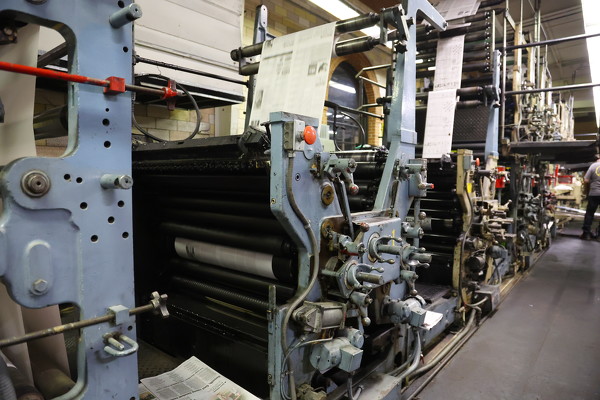
The current Goss offset press.

Lead pressmen Jake Snyder.
Press operator Jake Snyder has been in the press room since he was 14 and began by melting lead. Now 66, Snyder manually adjusts the press every night, aligning tiny marks on the paper to get the finished product looking just right. Snyder said the press room goes through about 500 to 1,000 papers a night to ensure the paper is colored and printed correctly.
The press uses yellow, cyan, magenta and black ink to create color for the newspaper. A five-gallon bucket of ink will last about a month.
The newspaper began with a hand press which printed 4 pages in 1848. About 100 years later, the newspaper switched to a letterpress, which would use lead templates to print onto paper. The Daily Standard now uses an offset press, which uses printed aluminum plates to print onto paper.
It can take upwards of five years to train someone to successfully run The Daily Standard's printing press, Snyder says. There's a science and art to adding color to a newspaper. Each printing plate has dots of corresponding colors which layer to create a four-color page.
Ads are placed on the page by ad representatives. Then page designers create a page in InDesign and fill it with text and photos. Once the paper is laid out for the night, it is sent to the press room. The pages are sent to the image setter, which then makes the aluminum plates. The images and text are burned onto the plate and then loaded onto the press for printing.
Jake Snyder said it is exceedingly rare for a newspaper to have its own printing press these days. He estimated the nearest newspapers that have their own press would be in Portland, Indiana, Wapakoneta and Delphos.
— Leslie Gartrell
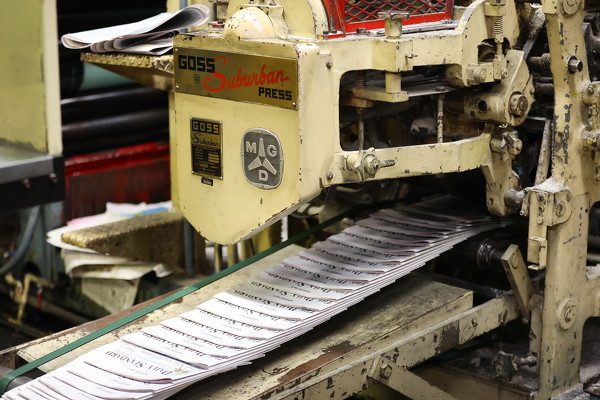
Newspapers roll off the press like a scene from an old movie.
---
In the beginning, there were no sports sections. Simply put, there wasn't a lot of leisure time 175 years ago.
While sports - specifically baseball, football and basketball - can trace their origins to the 19th century, the concept of newspaper pages or sections devoted to these activities is strictly a 20th century phenomenon. By 1917, readers were crazy about sports, and it was not uncommon to see daily stories about the World Series at the top of page one. There might even be a photo of a player. And a box score.
As Americans realized the value of nutrition and physical fitness, participation in high school sports climbed. Two-column ads announced upcoming games between local schools. The Daily Standard met the challenge, and breathless coverage of local games helped fuel rivalries that have lasted 100 years.
Now add other sports. And women's sports. And championships. During the worst of the COVID-19 crisis, when sports ground to a halt, The Daily Standard filled the void with full-page tributes to the area's best - our award-winning Amazing Athletes series. Suddenly it's easy to see how thousands of high school, college and professional athletes have appeared on Daily Standard pages over the years.
The Daily Standard is proud to have contributed mug shots, team photos, box scores and stories to so many area scrapbooks.
— Bill Thornbro

This is our commitment to you:
We promise to always punch above our weight, to strive every day to bring you the best possible newspaper in the state of Ohio. We are proud that so many of you turn to us for reliable news and information. And we hope you'll be reading and watching in 2048 when we celebrate our 200th anniversary.

Leslie Gartrell has been a reporter at The Daily Standard since January 2019.

Annette Schmitt works in the business office.

Reporter Bill Kincaid reads Wednesday's news budget.

Ellen Klosterman works in the business office.

Reporter and page designer Erin Gardner edits a story Wednesday afternoon.
